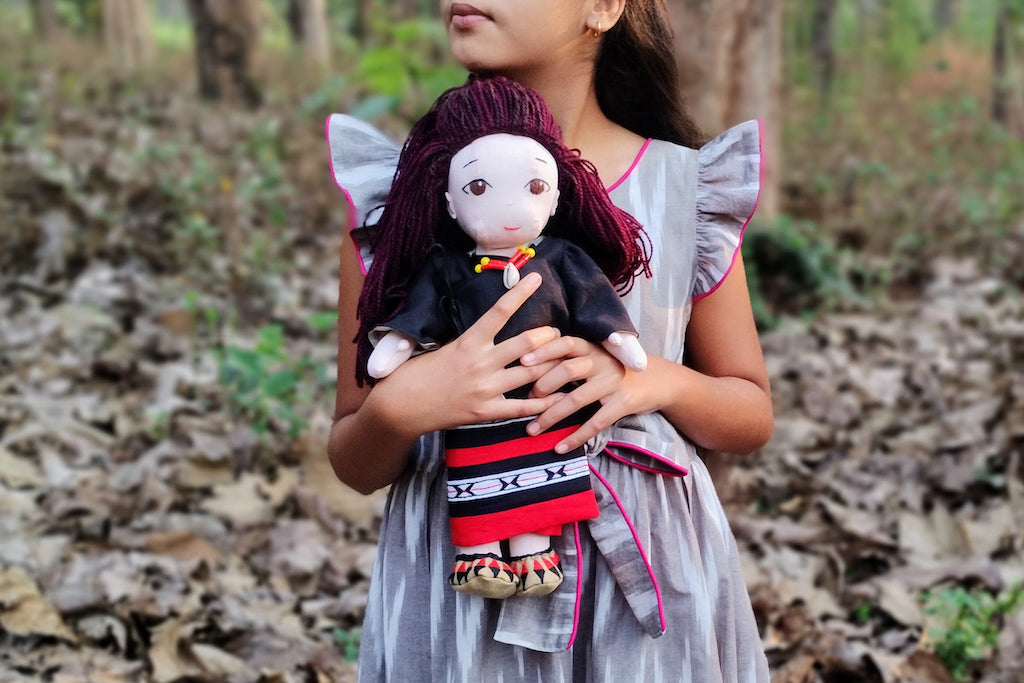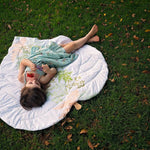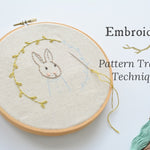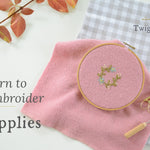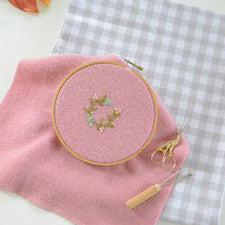We're so pleased to welcome Twig + Tale Storyteller Rhythm Tyagi to the blog this month, sharing her reflections on the theme Origins.
Rhythm used the Classic Cloth Doll pattern to create a doll for her daughter, and the Doll Clothes Bundle as the starting point to create the most beautiful wardrobe, inspired by the rich diversity of India. Sewing the doll gave Rhythm a chance to reflect on her own origins and how all the different places she has lived have become a part of her.


"Where are you from?" This seemingly simple question has always been one of the most challenging for me to answer. I grew up as an army brat and moved all over India. I never lived where my parents grew up or had a fixed hometown. Instead, I immersed myself in the culture and traditions of every place we called home. From the snow capped peaks of the Himalayas to the desert in the west and the rainforests of the northeast, each place left an indelible impression on me.
Navigating Identity Through a Doll
What does a doll mean to a child? A friend, a sibling, a role model? Maybe I was overthinking, but two issues were weighing heavily on my mind. Firstly, the issue of representation. Despite being one of the most populous countries in the world, Indians are often relegated to peripheral roles in mainstream media. The narrow beauty standards prevalent today fail to celebrate the rich diversity that defines us. Our youth see insufficient representation of their heritage, which erodes their connection to their origins over time. Secondly, the issue of non-realistic or stereotypical representation. There is nothing inherently wrong in the loud, bright, predictable tropes depicting India in the media, but they fail to capture our diversity.
I want my daughter to grow up celebrating her uniqueness, embracing and assimilating culture and values. So when I started the project I was mindful of this. When I was planning the doll's wardrobe, I wanted to showcase the lesser known textile traditions and what better place to start than Nagaland in the Northeast of India.

A journey to Nagaland - Museum Inspiration Strikes
I was on a visit to the Indian National Museum in Delhi when serendipitously in the tribal exhibit I spotted the most fabulous mekhala (wrap skirt) from the Liangmai tribe. By this time I had researched textiles from various other Naga tribes and was not able to narrow down on the right choice. The vibrant colors, patterns, and the specific motifs on the exhibited mekhala were truly inspiring and became my starting point.

Building the Look: A Reversible Top and Embroidered Shoes
Knowing that I wanted to create something that complemented the mekhala, I began with a simple black, reversible wrap top. This classic and versatile piece provides a perfect canvas to showcase the mekhala's beauty.
I decided to make embroidered shoes. I wanted to take a design element from the mekhala and translate it onto the footwear. This would create a cohesive look that ties the entire outfit together.

Capturing the Lithuina's Essence
The original Liangmai mekhala, the Lithuina, is a beautiful piece of craftsmanship. Handwoven on a loin loom, it comprises multiple panels that are meticulously stitched together.
Unlike most Naga mekhalas where the seams are celebrated, the Lithuina's brillinace lies in the concealed join. Here, the weavers (almost exclusively women) achieve this feat with a captivating technique - a vibrant red thread tightly looped and embroidered with black "bird" motifs.
Finding a small doll-sized handwoven mekhala was just not possible, so I tried my best to capture the intriguing details on my interpretation. I pieced together different fabrics and tried to embroidery the details.

Beyond the Wrap: A Multifunctional Shawl
Just like the mekhala, the matching shawl is a prominent part of the Naga attire. Worn in various ways, it offers both practicality and style. It can be transformed into a tube top, or provide warmth on chilly evenings. More importantly, it plays a vital role in everyday life, often used as a baby carrier. I created a simple shawl from fabric that complements the skirt.
A touch of Naga Jewelry
Naga jewelry is more than just adornment; it's a vibrant expression of identity and social status. Traditionally crafted from natural treasures like glass beads, corals, boar tusks, and shells, these pieces come alive in bold colours, often featuring symbolic elements unique to each tribe. Drawn to the vibrant aesthetics, I designed a simple necklace for my doll, using a mix of colourful beads that mirrored the traditional style.

A Doll's Journey Through Karnataka
Let me take you next to Karnataka where I live with my husband and daughter. It is a fascinating place. My partner's family and our community have been incredible teachers, introducing me to everything from delicious food to beautiful clothing.
Naturally, when it came to our doll's clothes, I wanted something authentic. In most Indian communities, the saree is omnipresent. However, not everyone finds it easy to handle, especially young children. That's where the langa davani, or "half saree" comes in!
This traditional outfit is perfect for little girls. It is essentially an ankle length skirt worn with a blouse. As girls get older, a dupatta (long scarf) is added, mimicking the drape of a saree - hence the "half" part.
Made from breathable cotton or silk, langa davani are known for their bright colours.
Karnataka has a very rich textile tradition. From the luxurious Mysore silk to the widely used black cotton soil-grown handloomed cottons from Ilkal, Sagara, and Udupi.
I made a silk brocade fabric pink langa/skirt using the simple skirt from the doll's clothes bundle. The raglan blouse is fashioned out of a gold tissue lining overlaid with an embroidered tulle fabric.


Beyond the Brights: A Chikankari Salwar Kurta for the Doll
For the final doll dress, I wanted to showcase the diversity of Indian clothing. While vibrant colours are a hallmark of many Indian styles, there are also beautiful traditions that favour elegant whites and lighter tones. These cooler shades are perfectly suited to India's warm climate and are quite popular.
Fond memories of Lucknow (in the North of India), where I spent part of my childhood, inspired me to incorporate Chikankari embroidery into the doll's outfit. Traditionally, Chikankari features white threadwork on white fabric, but modern variations embrace pastel base fabrics like the one I have used here. This delicate embroidery, known for its stunning shadow effect, utilizes stitches like chain stitch, backstitch, herringbone stitch etc. to achieve this.
I decided to make a white cotton salwar using the Pull-On Pants pattern. Additionally, I fashioned a kurta with a Chikankari adorned fabric using the Crossover Dress pattern. I love how this dress captures the essence of Chikankari's elegance and delicacy on a miniature scale!


Celebrating Origins
In crafting these diverse outfits for my daughter's doll, I realized that identity is not confined by borders or birthplaces. Each stitch, from each choice of fabric, is a tribute to the myriad cultures that have shaped me. From the vibrant textiles of Nagaland to the elegant traditions of Karnataka and the delicate artistry of Lucknow's Chikankari, I've embraced them as my own origins, hoping my daughter will embrace them as hers too. I look forward to seeing her enjoy this doll, and I hope it inspires pride in our resplendent heritage.
I am: Always lost
Always confounded
Unmoored
Root-less
Ever assimilating
Ever amalgamating
Evolving leisurely
Growing roots
Discovering origins



